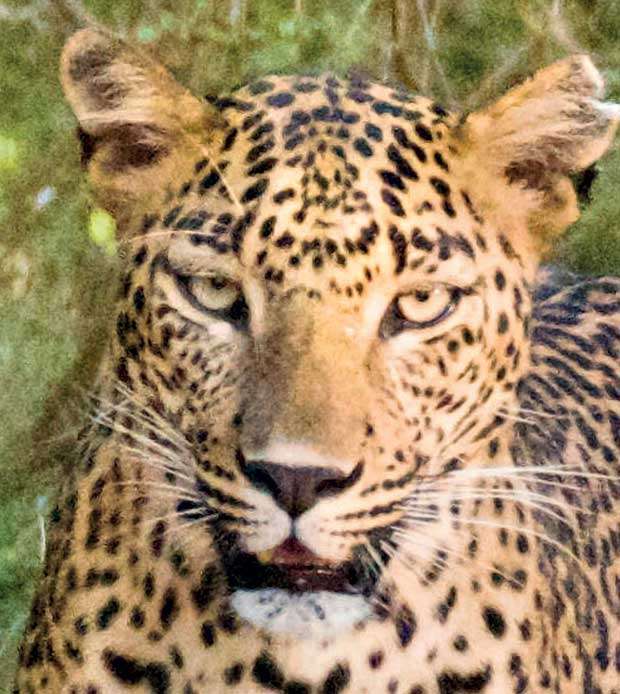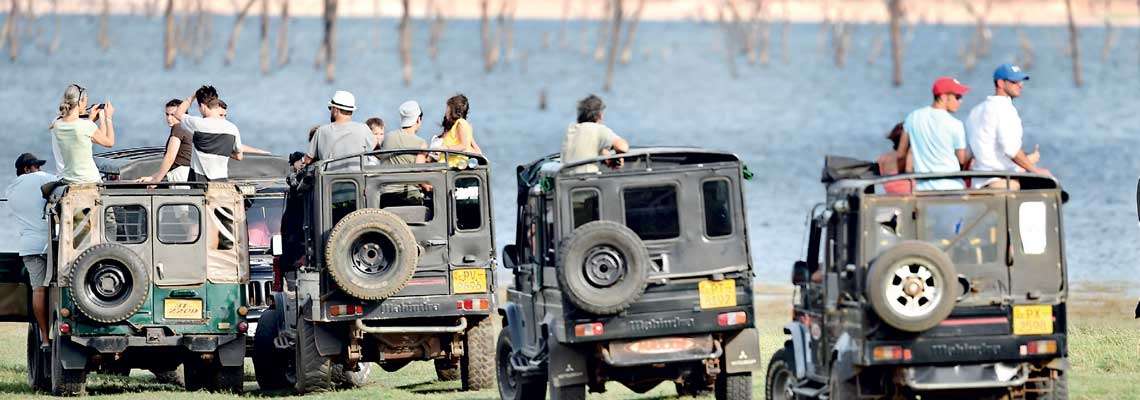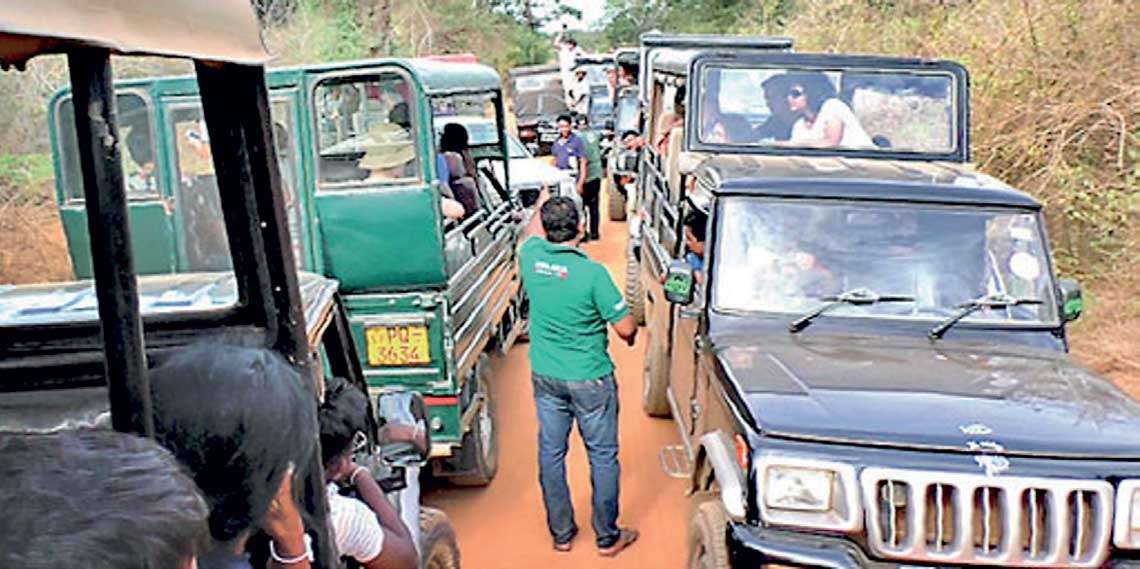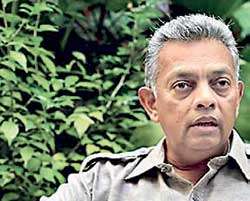29 Aug 2018 - {{hitsCtrl.values.hits}}

 Although Sri Lanka is blessed with many national parks, that stand out as potential tourist attractions, lately they have discouraged foreigners from visiting them owing to various reasons. While the mushrooming number of jeeps inside national parks and the unruly behaviour of jeep drivers have been major concerns among visitors and environmentalists, much hasn’t been done to curb this menace. A total wildlife experience is much more than chasing after a leopard or a bear. But visitors experience the opposite inside most national parks in Sri Lanka. As a result, the number of visitors interested in seeing wildlife is on the decline. Foreign tourists bring massive revenue to national parks daily and this decline is a huge blow to the tourism industry and the economy on the whole.
Although Sri Lanka is blessed with many national parks, that stand out as potential tourist attractions, lately they have discouraged foreigners from visiting them owing to various reasons. While the mushrooming number of jeeps inside national parks and the unruly behaviour of jeep drivers have been major concerns among visitors and environmentalists, much hasn’t been done to curb this menace. A total wildlife experience is much more than chasing after a leopard or a bear. But visitors experience the opposite inside most national parks in Sri Lanka. As a result, the number of visitors interested in seeing wildlife is on the decline. Foreign tourists bring massive revenue to national parks daily and this decline is a huge blow to the tourism industry and the economy on the whole.
Identifying the need to discipline jeep drivers and encourage them to interpret the nature, the Federation of Environmental Organisations along with the Department of Wildlife introduced a Nature Interpretation Programme. This programme brings together conservationists and environmental experts who focus on educating jeep drivers and tourist guides on the flora and fauna, mammals and their behaviour while also teaching them to maintain park discipline along with etiquette and personal presentation.
Hence the DailyMirror spoke to Rohan Wijesinha, former Secretary of the Wildlife and Nature Protection Society (WNPS) and Jehan Canagaretna who was also a member of the WNPS to find more about this initiative.
The Federation of Environmental Organisations (FEO) was setup as a trust to work with other organisations on conservation issues. In total they have around 30 organisations which are affiliates of FEO. “One major factor that influenced us to commence this initiative was a survey done on visitors to the parks,” said Wijesinha.“Foreign visitors contribute the biggest income to national parks. What influenced us was the fact that although 70% of the visitors saw a leopard, bear or an elephant, the experience they had was bad. This is a black mark not only against national parks, but the entire tourism industry. We need people to come back and tell their friends. So it’s a question of providing visitors with a quality service and not just quantity which we are doing now,” he said.
A message sent by a foreign visitor read : A majority of foreign tourists have visited parks in Africa and have voiced their concerns over the unruly behaviour of the jeep drivers when spotting tuskers, bear and leopard. Some of them have visited and hoped the situation would improve, but alas they had not and definitely we are not coming again.
Hence the jeep drivers are being trained to create a story around each park. Some of them don’t know the archaeological history of the parks
“These are the reasons why we came up with this idea,” Canagaretna added. “Everybody criticizes the jeep drivers, but in reality nobody has told them that they are killing their own livelihood. The jeep drivers have not been trained and it is also the tour guide’s fault. Based on that we came up with this concept and we also got a few panelists who had much knowledge about conservation-related areas. For example Dr.Sumith Pilapitiya is doing the elephant conservation aspect of the programme and talking about the human-elephant conflict etc. Depending on the parks we have different experts coming in to talk to the jeep drivers. If we take Wilpattu for instance it has a history of itself. But the jeep drivers are more concerned about the leopard and they drive past these archaeological sites which the tourists would be interested to see. Hence they miss out on other things in the park while they chase after the leopard. Most foreigners haven’t seen the barking deer and other species we could see at Wilpattu and if it could be interpreted properly, it would add more value to their ride. There are many other small animals and birds that are in a national park, but they are often missed,” added Canagaretna.
 The Programme
The Programme Speaking further, Wijesinha said that taking all this into consideration the FEO started off with locations that are easier to handle. “For example, Yala is a challenge as there are over 1000 jeep drivers at present and it would be too much of a task. Therefore we started off at Wilpattu and conducted one programme and it entails a couple of different aspects to the park. We speak about the park itself and for that we get an expert who knows the park well. Then we talk about the flora and fauna, mammals, reptiles, bird life etc. Through this we explain to the jeep drivers what they should be explaining to the tourists. For example if they see a painted stork they must talk about a key feature about it etc. Then we also teach them how to behave, how they should dress and how they should be addressing people etc. Here the biggest challenge is the language. Some of them would know German or Italian but they wouldn’t know English. In addition to that the Warden at the Park does a presentation about the DWC side of it. He speaks about the rules of the park, why they are there and how the drivers should behave keeping with the rules. From the feedback we received, we realized that it was the first time that the jeep drivers had participated in such a programme.
We also had an opportunity to show them our concerns as well. From our first programme we learned something for the second programme. After the first programme we gave them a questionnaire so that they could tell us what they thought about the programme. The second time we gave the questionnaire at the beginning and at the end of the programme. As a result we were able to find out how the answers differed. We give them a certificate and we work with the DWC and the Sri Lanka Association of Inbound Tour Operators (SLAITO) who endorses the certificate. So they will only use people who have followed the programme as they control 70% of the inbound operators in the country,” said Wijesinha.
Hence the jeep drivers are being trained to create a story around each park. Some of them don’t know the archaeological history of the parks. It’s an easy option for the youth in these areas to become jeep drivers, similarly to the places where young people become three-wheel drivers
Hence the jeep drivers are being trained to create a story around each park. Some of them don’t know the archaeological history of the parks. It’s an easy option for the youth in these areas to become jeep drivers, similarly to the places where young people become three-wheel drivers. As you start offering a quality service one can easily start charging.
Such programmes require a feedback process to ensure that the drivers have adhered to what they have learned. But the programme is organised as and when funds are available. “It’s difficult for us to monitor and it would be better if the DWC could do the monitoring,” Canagaretna said. “We also can obtain feedback through the SLAITO companies. We tell the jeep drivers that we are monitoring their performance. We are trying to implement this programme in all the national parks in the country. With this programme we are also trying to impose a limit. The visitation to some parks needs to be regulated. For example the visitation to Udawalawa is similar to Yala. Most of the jeep drivers realised the importance of preserving the park because at the end of the day it’s their livelihood. What’s happening at Yala has come as a huge warning. The message is also going out to tourists and we are trying to encourage a total wildlife experience,” he added.
 Speeding Jeeps within national parks have created much chaos PIC: AFP
Speeding Jeeps within national parks have created much chaos PIC: AFP
Challenges
The exorbitant rates charged by the travel guides are another issue. In most instances, tourists don’t get an experience worth the cost. Wijesinha further said that such exorbitant rates wouldn’t have been an issue if they give an experience worth the cost, but at the end of the day tourists don’t get either. One of the panelists is from SLAITO and he gives an input about how the tourists feel and the chaos going on in Yala. “We are showing that the tourists are not coming for the chaos but to get a good experience. Another problem that the jeep drivers encounter is that they are allowed to go on their own with the tourists. This is due to the lack of rangers. So they have a language barrier and they are scared to talk in English because they feel ashamed. Another issue is that there is a glass partition that separates the driver from the tourists at the back. So they anyway can’t talk anything,”said Wijesinha.
Sri Lankan visitors also create problems. As in most instances, they merely do not realise the value of our own resources. “They go and pollute the place,” Canagaretna said with much disgust. “If we go to India and Africa we wouldn’t drink the whole night and go for a safari ride the next morning. After all it’s your hard-earned money that you are spending. But this may not be so for locals. They would find the place fairly cheap enough and they would have a drink and go on the ride. So there are reasons why jeep drivers haven’t been behaving in the proper manner. Through this programme we are trying to tie it altogether. The more tourists say that they will not come, the jeep drivers should realise the risks they have in losing their jobs,”he reasoned.
Yala is a challenge as there are over 1000 jeep drivers at present and it would be too much of a task
Speeding jeeps within national parks have created much chaos, some even killing leopards and other mammals. According to Wijesinha the trackers and jeep drivers have mobile phones and when one of them spots a leopard, they will alert the others. “So once another jeep driver is tipped they charge with the hope that they too would spot it,” he added. “But obviously the animal doesn’t stay in one place. We want to change this thought-process and make it a total wildlife experience. We want them to think about the other mammals and birds other than only the leopard. It’s fun to watch elephant behaviour. One should go with an open mind to experience the park itself. Chasing the leopard is the biggest issue and that creates a lot of issues. It’s important to interpret nature around them and we hope we could slowly change their mind-sets through this programme,” added Wijesinha.

A total wildlife experience is much more than chasing after a leopard or a bear
The Daily Mirror also spoke to Asanka, a jeep driver, who participated in the programme. According to him this was the first time he got involved in such a programme. “The session on elephants was very interesting. Dr. Sumith taught us about the behaviour of elephants. I started this job back in 2003 and we knew very little about the wildlife aspect of it. It is important that all jeep drivers attend this programme as we could gather more knowledge about various aspects of wildlife,”said Asanka.
 Speaking to the Daily Mirror, Dr.Sumith Pilapitiya said that through this programme jeep drivers will be taught how to park the vehicles without disturbing the animals. “I focus on the elephant conservation aspect on a voluntary basis. Through this we train jeep drivers to observe and interpret what’s happening at an elephant gathering. If you observe a herd, many things are going on. So we want the jeep drivers to create a story around this event. They could observe the behaviours of males, how they behave during the musth season, how they choose a female etc.
Speaking to the Daily Mirror, Dr.Sumith Pilapitiya said that through this programme jeep drivers will be taught how to park the vehicles without disturbing the animals. “I focus on the elephant conservation aspect on a voluntary basis. Through this we train jeep drivers to observe and interpret what’s happening at an elephant gathering. If you observe a herd, many things are going on. So we want the jeep drivers to create a story around this event. They could observe the behaviours of males, how they behave during the musth season, how they choose a female etc.
We also discuss briefly about elephant communication. This programme will be quite effective and already the response has been positive. It should expand beyond Minneriya and we want to ensure 100% participation as we proceed with this initiative. In the long run we want to make sure that the DWC makes training a mandatory aspect for all jeep drivers and make this programme a monthly or a yearly workshop,” said Pilapitiya.
DR. sumith pilapitiya
23 Dec 2024 36 minute ago
23 Dec 2024 42 minute ago
23 Dec 2024 50 minute ago
23 Dec 2024 1 hours ago
23 Dec 2024 1 hours ago